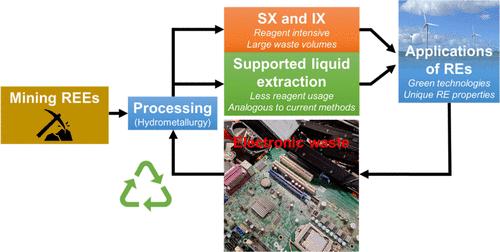基于聚合物的提取材料在稀土元素绿色回收利用中的应用:综述
IF 3.7
3区 化学
Q2 CHEMISTRY, MULTIDISCIPLINARY
引用次数: 0
摘要
稀土元素(REEs)在现代绿色能源技术的发展中正变得越来越重要,预计在可预见的未来,对稀土元素的需求将不断增长。稀土元素的重要性在于其独特的物理化学特性,这是其他元素无法复制的。REEs 的来源是采矿,目前全球仍在勘探更多商业上可行的矿址。然而,由于目前的稀土供应无法满足日益增长的需求、稀土开采和加工对环境的影响(所谓的 "平衡问题")以及产生大量有害电子废物(电子垃圾),对稀土回收利用的需求日益增长。工业 REE 加工主要采用湿法冶金工艺,特别是溶剂萃取 (SX) 和离子交换 (IX) 技术。然而,这些方法由于大量使用有害和不可持续的试剂,对环境造成了严重影响。本综述重点介绍涉及聚合物基萃取材料的 REE 制造方法的发展情况,这些方法是当前工业 REE 加工方法的更可持续的替代方法。这些材料包括支撑液体膜 (SLM)、溶剂浸渍树脂 (SIR)、大胶囊和小胶囊、聚合物包合物膜 (PIM) 和微聚合物包合物珠 (μPIB)。聚合物萃取材料的优点是使用更经济的萃取剂,同时使用与商业 SX 相同的萃取剂,从而实现与当前工业流程类似的应用。这些材料可以通过各种方法以不同的物理形式制造,本综述将介绍和讨论每种材料类型的优缺点,以及它们在 REE 处理(包括电子废物回收和矿物加工)中的应用。本文章由计算机程序翻译,如有差异,请以英文原文为准。

Polymer-Based Extracting Materials in the Green Recycling of Rare Earth Elements: A Review
Rare earth elements (REEs) are becoming increasingly important in the development of modern and green energy technologies with the demand for REEs predicted to grow in the foreseeable future. The importance of REEs lies in their unique physiochemical properties, which cannot be reproduced using other elements. REEs are sourced through mining, with global exploration of additional commercially viable mining sites still ongoing. However, there is a growing need for recycling of REEs due to the current supply of REEs not matching the growing demand, the environmental impact of REE mining and processing (the so-called “balance problem”), and the generation of large volumes of harmful electronic waste (e-waste). Industrial REE processing is mainly carried out by hydrometallurgy processes, particularly solvent extraction (SX) and ion exchange (IX) technologies. However, these methods have a significant environmental impact due to their intensive use of harmful and nonsustainable reagents. This Review highlights the development of approaches involving polymer-based extracting materials for REE manufacturing as more sustainable alternatives to current industrial REE processing methods. These materials include supported liquid membranes (SLMs), solvent impregnated resins (SIRs), macro and micro capsules, polymer inclusion membranes (PIMs), and micro polymer inclusion beads (μPIBs). Polymer-based extracting materials have the advantage of more economical regent usage while applying the same extractants used in commercial SX, enabling applications analogous to the current industrial process. These materials can be fabricated by a variety of methods in a diverse range of physical formats, with the advantages and disadvantages of each material type described and discussed in this Review along with their applications to REE processing, including e-waste recycling and mineral processing.
求助全文
通过发布文献求助,成功后即可免费获取论文全文。
去求助
来源期刊

ACS Omega
Chemical Engineering-General Chemical Engineering
CiteScore
6.60
自引率
4.90%
发文量
3945
审稿时长
2.4 months
期刊介绍:
ACS Omega is an open-access global publication for scientific articles that describe new findings in chemistry and interfacing areas of science, without any perceived evaluation of immediate impact.
 求助内容:
求助内容: 应助结果提醒方式:
应助结果提醒方式:


